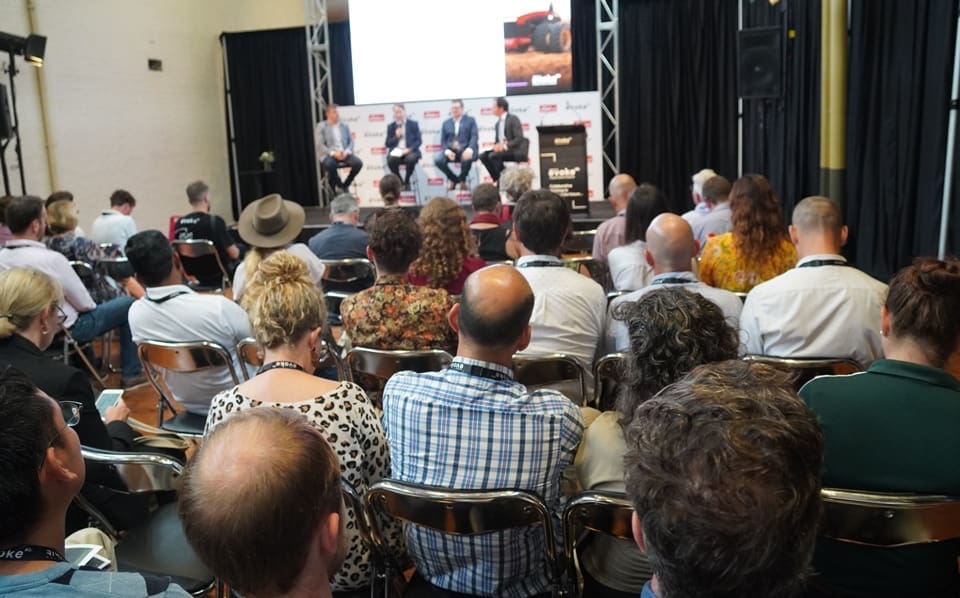
Panelists Ian Reilly, eShepherd (speaking), Darren Keiller, Autogrow, and Andy Clarke GAIA Innovations with moderator Tom Rayner during an EvokeAg panel session this week
CHALLENGES surrounding the adoption of ag technologies by producers surfaced during discussion at a number of panel sessions held during Melbourne’s EvokeAg event this week.
A panel session focussed on whether artificial intelligence and remote sensing can take the leg-work out of farming, with speakers suggesting rates of adoption were related to change management, and whether people who “felt threatened by something they did not understand” were likely to put up barriers.
“Understanding what (technology) opportunities are out there is one thing, but having that follow-through in how to approach it, and potentially put it into practice is critical,” said panellist Andy Clarke from GAIA Innovations.
He also acknowledged the generational change that was evolving in farming was playing a big part in the adoption challenge.
Ian Reilly from Agersens, the agtech developer behind the eShepherd virtual fencing technology, said one of the biggest challenges for ag technologies – particularly those related to livestock – was the enormous variety of business models, climate types, opportunities and scale that was evident across the Australian farming community.
“Just within beef alone, there is a huge variety of business models from one part of the country to another. The challenge for any company that has a tech product they want to market directly to those producers is to make it relevant to all – and the same applies in North America and Europe,” he said.
Mr Reilly said there were a whole range of perceived barriers to tech uptake in farming, at a number of levels.
“One of the more common ones, that I think is a bit of a myth, is that farmers by and large are not tech savvy and will not adopt new technology.”
“My personal experience of that is that it is complete rubbish. Farmers since the agricultural revolution started in the 18th century have been ready adopters of new technologies, and continue to do so, as soon as it comes available and proven,” Mr Reilly said.
“But it has to be something that is fundamentally useful to their business. That means it either cuts labour and gives them more time, to do more worthwhile things; improves the productivity or viability of their business; or reduces risk factors in their production system.”
The challenge for some ag technologies, especially those generating a lot of data, was what to do with that data – turning the raw data into a decision, and turning that decision into action.
“The worst thing you can do, as an agtech developer, is deliver something that is going to create more work for the farmer and more jobs to do,” Mr Reilly said. “That is a very significant barrier, in itself. Come up with a product or application that reduces labour and workload and producers are all-ears.”

A delegate’s question suggested that automation, at this stage, appeared to be much further advanced in indoor and intensive farming, but asked the panel whether it would ultimately extend into extensive agricultural operations, like livestock.
Panellist Darren Keiller, from Autogrow, said he was seeing automation transfer both ways – from extensive to intensive, and the opposite.
“Machine vision systems are a good example, which I think are going to be one of the really big, transformative advances to come in agtech,” he said.
“The fact is, it’s talked about a lot, but is still not readily available in commercial agriculture. We’re currently doing work in flowering and fruit measurement in tomatoes, to automate a process using camera systems that is currently a laborious manual process, to instruct management interventions. But we need to make sure we’re not creating technology for technology’s sake. We have to make sure it creates a usable product that creates an advantage for the user in some way – ideally through an easy-to-understand users interface.”
What’s the next ‘Big Thing’?
Delegates were also interested to hear what panellists expected to see as the ‘next big thing’ in the artificial intelligence and remote sensing field.
Ian Reilly said over time, he expected to see some rationalisation of agtech companies.
“if you think back to the 1980s and 1990s, there were numerous electronic chip and hard-drive manufacturers, but over time some disappeared, and some amalgamated, where today we have a very limited set of technologies in each segment, held by a few major companies around the world.
“Auto-steering technology has followed the same pattern. At one stage there were up to eight separate companies in Australia working on auto-steering, but that technology is now owned by just three major companies around the world.
“That will continue to happen in the agtech space, but it may take a 20 year timeframe for that to occur.”
“It’s always difficult predicting the next ‘big thing.’ I think there won’t be a single ‘thing’ but a gradual trend in the agtech space, as technologies start to integrate. It will come in a very organic way,” Mr Reilly said.
“There will be winners and losers; things will grow for a while and then disappear; but it will be driven largely by the feedback from our farmers trying to implement new technologies in their businesses to improve their productivity and profitability and sustainability.”
Panelist Andy Clarke nominated activities like yield estimation and disease monitoring capability as goals for future farming tech breakthroughs, but how soon developers could get there, time would tell.
Panellist Darren Keiller, from Autogrow, said the long-run goal for his business was autonomous systems. “We have the ability to realise that because of the nature of the types of farming applications were are targeting – mostly indoor greenhouses – but it could expand into extensive farming systems. In the nearer-term, machine vision-based systems and voice-activated systems are on the horizon for farming.”



HAVE YOUR SAY